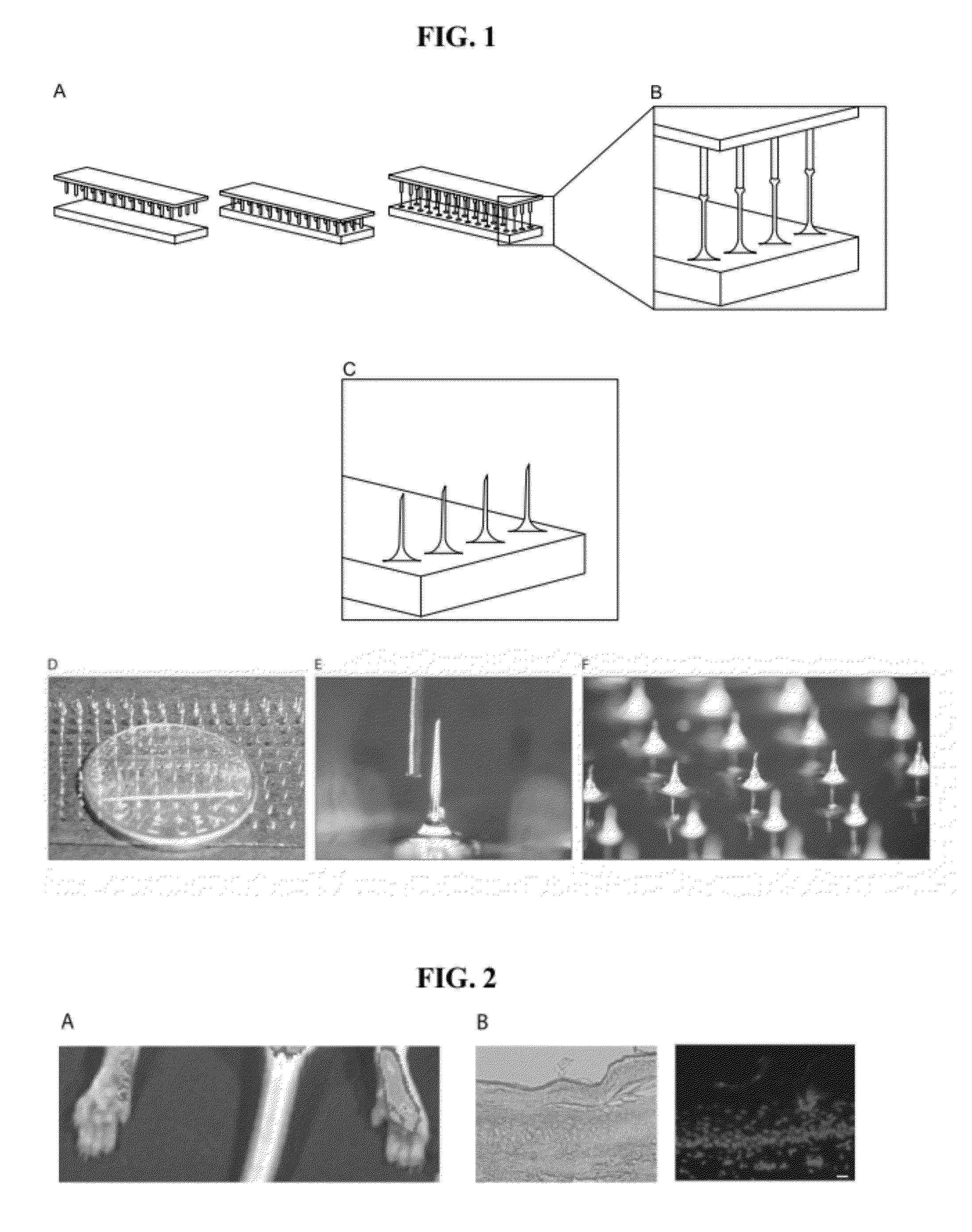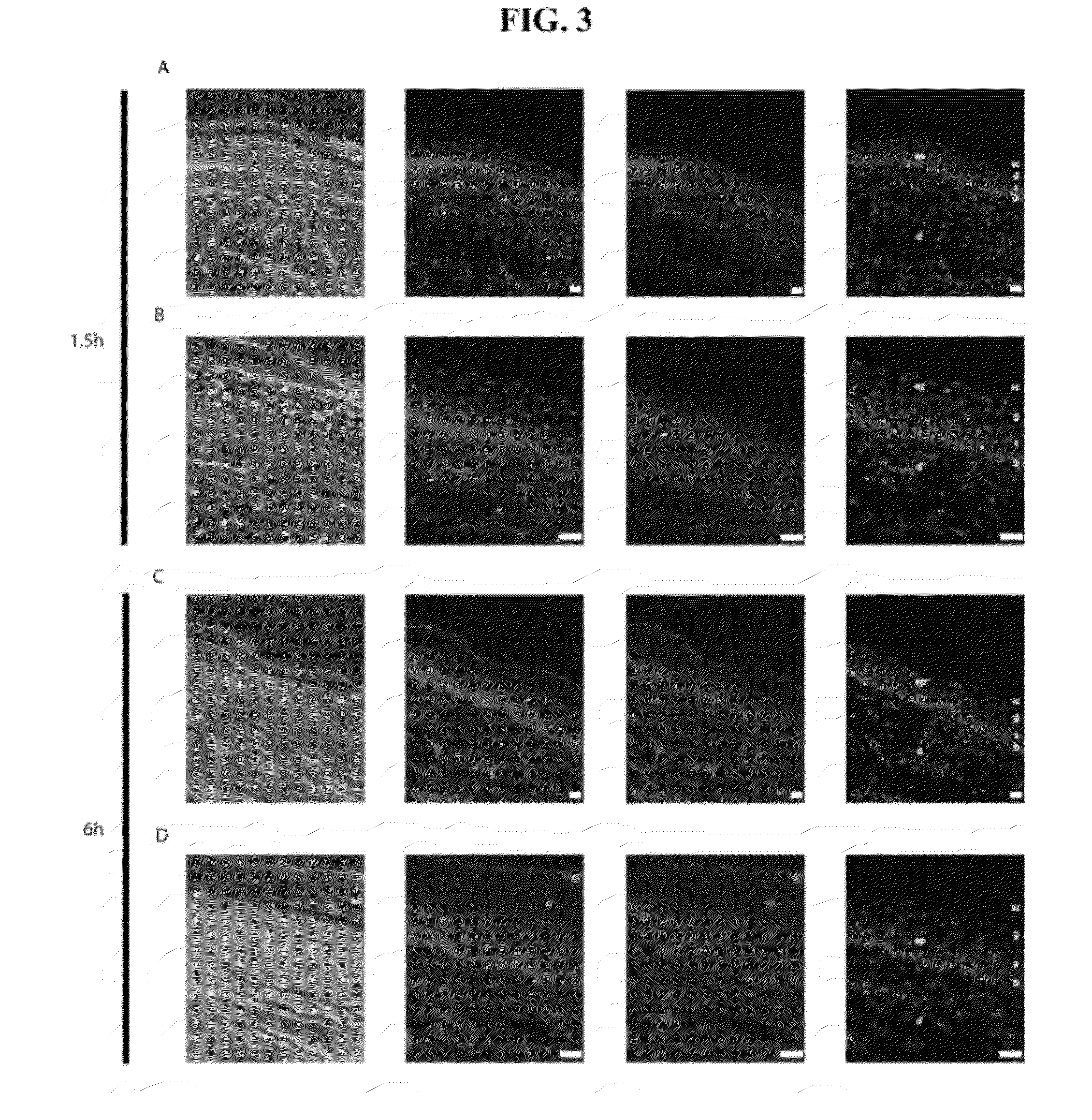Microneedle arrays for active agent delivery
a technology of microneedle arrays and active agents, which is applied in the direction of application, antibody medical ingredients, peptide/protein ingredients, etc., can solve the problems of difficult transdermal delivery of active agents, significant challenges associated with the delivery of some types of active agents, and the delivery of these active agents, so as to effectively vaccinate a subject against a disease, the effect of stimulating the immune respons
- Summary
- Abstract
- Description
- Claims
- Application Information
AI Technical Summary
Benefits of technology
Problems solved by technology
Method used
Image
Examples
example 1
Microneedle Array Device Preparation
[0051]Microneedle arrays were produced by bringing a pin template into contact with a 1 mm thick film of 20% wt. polyvinyl alcohol (PVA) solution (FIG. 1A, left and middle panels), and withdrawing the template under a controlled air flow to produce fiber-like structures with loadable channels (FIG. 1A, right panel and B). The dried needle structures are separated from the template, and mechanically trimmed to a uniform height with sharp beveled tips (FIG. 1C). Typical fabrication and drying of microneedle arrays occurs at or below 50° C. (as low as 30° C., data not shown), below established siRNA degradation temperatures. The device is removed from the substrate as a regular array of dissolvable microneedles with an integral material backing (FIG. 1D). Typically, the microneedles on the microneedle arrays can be less than 100 μm thick, with a sharp tip only microns across (FIG. 1E). Microneedle arrays can be loaded with aqueous solutions or suspen...
example 2
Microneedle Array Device Preparation, Delivery and Application
[0052]Microneedle arrays were produced using an assembly of commercially available “pin headers” (Header Strip 80 pin dual row 1 mm spacing, PED-80S-P2, PAN PACIFIC, Santa Cruz, Calif.), as templates. The fabrication of the microneedles was accomplished by bringing the template pattern of projections into contact with a 1 mm thick film of 20% wt. polyvinyl alcohol (SPECTRUM, Gardena, Calif.) polymer solution on a glass substrate (Microscope Slides #1324L Globe Scientific, Paramus, N.J.). Following contact with the polymer film, the projections were withdrawn a distance of 1 cm over 13 s under a uniform airflow of 3.0 m / s at 45° C. Under these conditions, needle structures can be formed in the film with a hollow interior or exterior groove, which can be subsequently loaded through “capillary action.” Such microneedles were produced and mechanically trimmed to a nominal 1.0 mm length and 45 degree bevel, and loaded with “ca...
example 3
Analysis of siRNA Distribution in Mouse Footpad Skin
[0053]Microneedle arrays were loaded with ˜20 ng / microneedle of the DY-547 (a Cy3 analog; 557 nm excitation, 570 nm emission) fluorescently-tagged siRNA mimic siGLO Red or Accell Red Non-Targeting siRNA (Dharmacon Products, Thermo Fisher Scientific, Lafayette, Colo.). The microneedle arrays were applied to the left paw of an FVB mouse using four consecutive applications of arrays (1×4) containing four microneedles each. Each microneedle array was applied for 20 minutes to maximize hydration of the penetrating microneedles. As a positive control, the right paw received 0.5 μg of siGLO Red in 50 μl PBS solution via intradermal injection. Mouse paws were imaged in an IVIS 200 imaging system using the DsRed filter set (excitation at 460-490 nm and 500-550 nm; emissions at 575-650 nm) during 1 s acquisition time. The resulting emitted light was quantified using LivingImage software (Caliper LifeSciences), written as an overlay on Igor i...
PUM
| Property | Measurement | Unit |
|---|---|---|
| diameter | aaaaa | aaaaa |
| diameter | aaaaa | aaaaa |
| time | aaaaa | aaaaa |
Abstract
Description
Claims
Application Information
 Login to View More
Login to View More - Generate Ideas
- Intellectual Property
- Life Sciences
- Materials
- Tech Scout
- Unparalleled Data Quality
- Higher Quality Content
- 60% Fewer Hallucinations
Browse by: Latest US Patents, China's latest patents, Technical Efficacy Thesaurus, Application Domain, Technology Topic, Popular Technical Reports.
© 2025 PatSnap. All rights reserved.Legal|Privacy policy|Modern Slavery Act Transparency Statement|Sitemap|About US| Contact US: help@patsnap.com



